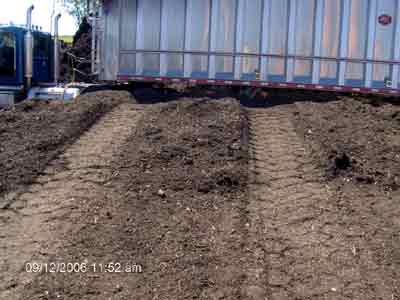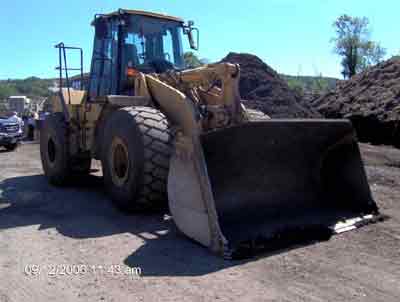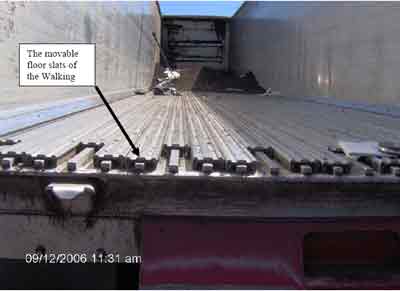Truck Driver Buried by Mulch at Town Solid Waste Site
New York Case Report 06NY084
Summary
In September 2006, an adult truck driver employed by a trucking company sustained fatal injuries after being buried by mulch in his trailer at a town solid waste site. At the time of the incident, the victim’s tractor trailer was being loaded with mulch. The trailer was equipped with a walking floor unloading system. After the town loader operator deposited one bucket of approximately five cubic yards of mulch into the trailer, he noticed that the trailer door was open and the victim was not in the cab. The operator became concerned and called for help. One town staff member called 911. In the meantime, town workers started digging into the compost pile in the trailer. The temperature of the mulch was approximately 135 degrees Fahrenheit. The police arrived at the site followed by paramedics within minutes after the 911 call was placed. The unconscious victim was uncovered 15 minutes later. The victim was transported to a hospital and subsequently died as a result of the injuries. After the incident, a piece of blue tarp was found in the mulch. It is believed that the victim may have entered the trailer through the trailer door to cover the front section of the walking floor with the tarp to reduce manual sweeping.
New York State Fatality Assessment and Control Evaluation (NY FACE) investigators concluded that to help prevent similar incidents from occurring in the future, owners of solid waste facilities should:
- develop and enforce a standard safe loading/unloading procedure for both facility personnel and visiting drivers; and
- provide frequent training for all facility personnel on the standard safe loading/unloading procedure.
In addition, trucking companies should:
- develop standard safe trailer cleaning procedures and require all drivers to strictly follow the procedures; and
- provide frequent employee training to ensure that the truck drivers understand and follow site specific safety procedures while picking up or delivering cargos at solid waste facilities.
Introduction
In September 2006, an adult truck driver employed by a trucking company sustained fatal injuries after being buried by mulch in his trailer at a town solid waste site. Both the Occupational Safety and Health Administration (OSHA) and the New York State Public Employee Safety and Health (PESH) Bureau investigated the incident. This report is based on the information provided by OSHA, PESH, and the manufacturer of the walking floor that was installed on the victim’s tractor trailer.
There were approximately 18 employees working at the town solid waste site where the incident occurred. The solid waste site had developed standard safety procedures for waste handling operations such as mulching and loading. The victim worked for a trucking company that had four employees. The trucking company had basic safety and health programs required by OSHA. It was the first fatality for the trucking company.
Back to Top
Investigation
On the morning of the incident, the victim was at the town solid waste site having his tractor trailer loaded with mulch. The victim parked the rig with the front part of the trailer next to a raised loading ramp (Photo 1) as directed by the town staff. A town equipment operator was to load the mulch with a front end loader (Photo 2). The town waste site loading procedure required a driver to stay in the cab when at the loading spot and to remain in the cab for the entire duration of the loading operation. According to the site’s procedure, a driver would be expected to move the vehicle forward during loading in order to distribute the mulch evenly within the trailer. The loading operator assumed that the victim knew and understood the procedure since he had picked up mulch at the town site before.

|
|
Photo 1. The victim’s tractor trailer was parked next to a raised loading ramp during the incident |
After the loader operator deposited the first bucket of approximately five cubic yards of mulch into the trailer, he noticed that the trailer door was open and the victim was not visible in the cab. The operator looked around but was unable to locate the victim. He became concerned and called for help. One town staff member called 911. In the meantime, town workers started digging into the compost pile in the trailer. The temperature of the mulch was approximately 135 degrees Fahrenheit. The police arrived at the site followed by paramedics within minutes after the 911 call was placed. The unconscious victim was uncovered 15 minutes later. The victim was transported to a hospital where he later died as a result of the injuries.
 |
|
Photo 2. The front-end loader that was involved in the incident |
The trailer was equipped with walking floor, an automated unloading mechanism (Photo 3). The walking floor was composed of three groups of narrow movable slats that were powered by hydraulics. The groups of floor slats could move alternately or simultaneously forward and backward. The load was moved during unloading when all floor slats moved simultaneously towards the discharge end. The company reported that drivers usually cover the front trailer wall and a section of the floor before loading. It was believed that the tarp that moved along with the load could keep debris off the floor and reduce manual sweeping after unloading. After the incident, a piece of blue tarp was found buried in the mulch in the trailer. It is believed that the victim may have entered the trailer from the rear to cover the walking floor with the tarp just prior to when the loader operator approached the trailer with the first load of mulch.
The loader operator did not notice that the trailer rear door was open when he dumped the mulch into the trailer. According to the operator, the door may have been open just wide enough to allow the victim to enter. From the angle where he was working, the operator could not see the door ajar. The loader operator believed that the trailer door might have swung open by the impact of the first load of mulch.
 |
|
Photo 3. The victim’s trailer was equipped with a walking floor |
Back to Top
Recommendations/Discussion
Recommendation #1: Owners of solid waste facilities should develop and enforce a standard safe loading/unloading procedure.
Discussion: The mulch loading operation in this case involved at least two persons: the loader operator and the truck driver. Due to the hazards associated with loading and unloading operations involving heavy mobile equipment that handle large and heavy cargo, miscommunication between the parties involved can result in serious or fatal injuries. Although the solid waste facility had a loading/unloading procedure, the procedure was not followed in this case.
Owners of solid waste facilities should develop and enforce a standard safe loading/unloading procedure to ensure the safety of all personnel in the area. Owners of the solid waste facilities should consider the following actions:
- Assign a site traffic coordinator to monitor the loading operation and the traffic in loading area;
- Require a loader operator to refrain from discharging a load unless he sees that the driver is inside the cab;
- Require all visiting drivers to remain in the cab during loading. If a driver has to leave the cab in the loading area, the driver must communicate his intention to the traffic coordinator. The driver should remain in the cab unless he receives clear feedback from the traffic coordinator that all parties are informed of his intention and it is safe for the driver to leave the cab. A two-way radio system may be used in addition to conventional communication measures such as visual contact and hand signals; and;
- Monitor and enforce the standard safety procedure to both site personnel and visiting drivers. Apply appropriate disciplinary actions if necessary for hazardous deviations in the procedure.
Recommendation #2: Owners of solid waste facilities should provide frequent training for all facility personnel on the standard safe loading/unloading procedure.
Discussion: Owners of solid waste facilities should provide frequent training to all facility personnel who work in loading zones to ensure that they strictly follow the standard safe loading/unloading procedure. The training should emphasize the serious outcomes possible if the procedures are not followed.
Recommendation #3: Trucking companies should provide frequent training to ensure that their truck drivers understand and follow site specific safety procedures while picking up or delivering cargoes at solid waste facilities.
Discussion: Due to the size and configuration of the heavy mobile equipment such as a front-end loader, the mobile equipment operator may have a large blind spot area and may not be able to see people walking around the equipment. A driver is at great risk of being run over if he exits his truck during loading and unloading. The hazards related to entering a trailer during loading should also be addressed. These hazards may include entrapment and engulfing and can result in serious injury or death as in this case.
Trucking companies should train their truck drivers to recognize and avoid the hazards associated with loading and unloading. The employers should ensure that their drivers clearly understand and strictly follow the site-specific safety loading/unloading procedure.
Recommendation # 4: Trucking companies should develop standard safe trailer cleaning procedures and require all drivers to strictly follow the procedures.
Discussion: Trucking companies should develop standard safe trailer cleaning procedures and require their drivers to strictly follow the procedures. Drivers should be required to complete all preparation work before pulling up to a loading area and to remain inside the cab until the trailer is loaded. A driver should never leave the cab unless he communicates his intention with the site traffic coordinator and receives a clear signal that it is safe to exit the cab. Employers should provide frequent training on safe cleaning procedures.
According to the victim’s employer, drivers usually covered the front trailer wall and section of the walking floor with a tarp before loading in order to reduce manual sweeping. However, the walking floor manufacturer stated that this practice did not always reduce manual sweeping.
There are different types of floor slats for handling different cargos: some have relatively smooth surfaces while others have ridges and deep grooves or “valleys”. According to the walking floor manufacturer, depending on the types of floor slats and cargo being handled, covering the floor with a tarp may not reduce sweeping. In this case, the victim’s trailer had the floor slats with deep grooves. The tarp would not have prevented the debris from depositing in the grooves. However, if the walking floor in this case were composed of smooth slats, the tarp would have kept the debris off the floor and therefore reduced the sweeping.
An automated tarp system with controls on the exterior of the trailer is available through walking floor manufacturers and dealers. The system allows the driver to position the tarp without entering the trailer. Employers should consult with manufacturers or dealers to select appropriate floor slats and determine the proper cleaning methods. Should a tarp be used, employers should consider installing the automated tarp system.
Keywords: solid waste facility, tractor trailer, walking floor, truck driver, front end loader, buried by, mulch.
References
Washington State Fatality Assessment and Control Evaluation Program: Hazards to Truck Drivers Loading and Unloading.pdf iconexternal icon [Online] Available at http://www.lni.wa.gov/Safety/Research/FACE/files/LoadUnload.pdf (Accessed May 8, 2008)
New York FACE Program
The Fatality Assessment and Control (FACE) program is one of many workplace health and safety programs administered by the New York State Department of Health (NYS DOH). It is a research program designed to identify and study fatal occupational injuries. Under a cooperative agreement with the National Institute for Occupational Safety and Health (NIOSH), the NYS DOH FACE program collects information on occupational fatalities in New York State (excluding New York City) and targets specific types of fatalities for evaluation. NYS FACE investigators evaluate information from multiple sources. Findings are summarized in narrative reports that include recommendations for preventing similar events in the future. These recommendations are distributed to employers, workers, and other organizations interested in promoting workplace safety. The FACE program does not determine fault or legal liability associated with a fatal incident. Names of employers, victims and/or witnesses are not included in written investigative reports or other databases to protect the confidentiality of those who voluntarily participate in the program.
Additional information regarding the New York State FACE program can be obtained from:
New York State Department of Health FACE Program
Bureau of Occupational Health
Flanigan Square, Room 230
547 River Street
Troy, NY 12180
1-866-807-2130
http://www.health.ny.gov/environmental/investigations/face/external icon (Link updated 4/8/2013)
